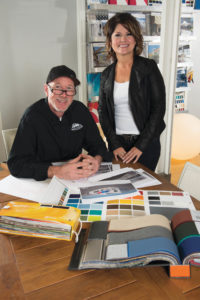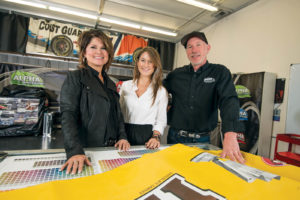Eric and Angie Riggins create new products and capture new markets to ensure a steady stream of work throughout the year.

We’re always looking for opportunities to grow the business,” says Angie Riggins, co-owner of Alpha Canvas, Charlotte, N.C. “We have to be innovative to set ourselves apart from our competitors—we find ways to meet our customers’ visions; we don’t turn work down; and we develop our own products.”
Alpha Canvas has been serving the greater Charlotte area with custom awnings since 1983 when Eric Riggins’ parents founded the company. Eric, then 18 years old, began working as a fabricator and installer, taking on more responsibility over the years. Angie worked in a part-time capacity on and off until, approximately 10 years ago, Eric’s parents retired, and Eric and Angie inherited the business.
As working owners, Eric and Angie oversee every aspect of the business. They both handle sales; Eric turns concepts into real world products, and Angie handles the business side of things, including customer service. Three of their seven children also work with them. Their son Eric Jr. is lead installer and son Jesse also works installation. Daughter Olivia graduated from Appalachian State University in May with a degree in business and took over doing the books, a responsibility that previously was Angie’s. “Having Olivia here full-time is going to allow me to take some things off my plate,” Angie says. “Now I can concentrate more on growing the business.”
NEW BUSINESS
It’s become second nature for Eric and Angie to recognize—and capture— opportunities for growth that are a good fit for Alpha. In the late 80s the company made its first major market expansion by creating its Race Products division, which provides different race teams with cutting-edge waterproof canvas covers, including marketing solutions for race sponsors with digital printing capabilities.
The Race Products division ultimately was created after one of Eric’s friends who worked on a NASCAR race team called him for help, because he was having trouble managing his current car cover when it got wet. “He’s kind of a small guy and he said that when it rained and the cover got wet he had to put it in a wagon and pull it around,” Eric says. “He needed a lightweight cover.”
The Riggins family and Alpha staff developed a lightweight cover for him, added it to the company’s product offerings, and the following year recognized the possibilities within the market and decided to make pit equipment covers as well. Soon after, Alpha brought graphics capabilities in-house. “There are graphics on some awnings, of course, but there are a tremendous amount of graphics on race covers because of the sponsorships,” Angie says.
“When the economy hit the downturn, race team sponsorships were affected. It usedtobethatlargeteamshadonesponsor all year long; now even they have multiple sponsors, which means a lot of changeover in the wintertime. We freshen up their transportation covers and get the new sponsors’ graphics on them.”
The downturn in the economy led Eric and Angie to expand Alpha’s product offerings again, this time into the canopy and mobile market—Alpha Canopy & Mobile Solutions became the third division of the business. “We had been doing some mobile canopy work before then, but primarily repairs and maintenance,” Angie says. “Then we asked ourselves: Why aren’t we manufacturing these? And so we started making mobile canopies as well. It keeps us busy as an awning company year-round, which is not the norm for awning companies.”
The market segments the Riggins expanded into were natural extensions of whatAlpha Canvas alreadydid, and because of the similarities the production demands are similar. “It’s all fabric, framework and graphics,” Angie says. “We’re able to use all the same production and scheduling practices and setup for all three different product lines, so it all fits well into the way the products flow through the shop.”
WEIGHTY WORKLOAD

Work for the race industry all ends up having the same deadlines, however, so the Alpha team works a lot of overtime during the winter to meet the demand. “The first race of all the race teams have the same deadline, so we’ll get 20 different teams with orders and they all have the same due date,” Eric says. “We’ve built a culture here where everybody expects to work long hours during those times, even into the night if necessary.”
What also helps the team meet deadlines is that Eric and Angie keep the entire production process in-house, from design to fabrication to installation. “That’s a rarity in this industry,” Eric says. “It allows us to control the quality and turnaround time for everything.”
As the company has expanded, so has its need for employees. Eric and Angie have hired seven people in the past few months to keep up with the workload. One of the new hires is a design engineer, who does detailed concept drawings for potential clients. “We have the capability to show detailed concepts of what the finished project will look like,” Angie says. “For instance, let’s say we’re doing an outside awning with a curtain enclosure for a restaurant. We can show the client what it will look like from outside the building and even walking underneath the awning. We show interior views, day views and night views. Having that level of concept detail really helps to sell a product.”
DESIGN TO PLEASE
Eric and Angie also set Alpha Canvas apart from the competition by developing products. In 2007 they developed a curtain system for restaurants. “We designed the system to be super rugged and simple to operate because the employee turnover rate is so high for restaurants,” Angie says. “And we designed it so we can work around existing columns and such.”
“Our restaurant patio business has taken off because we’ve been able to provide a really nice solution for a lot of places that have been told: ‘No, you’re not a candidate for curtains on this patio,’” Eric says. “Other companies will say it won’t work and will walk away. Our system is customizable and we can make it work.”
A few years ago, based on the success of the curtain system, Alpha Canvas began to partner with restaurant chains to provide patio curtain work. “I thought, we need to be doing all their work, so I started to talk with them about it,” Angie says.
“I cannot stress enough how important it is to pay attention when you’re talking to any lead, any customer, looking for your next opportunity. You have to have your eyes and ears open at all times, and when that opportunity does come, you don’t waste it. You bust your tail and go above and beyond to earn that business.”
When Bad Daddy’s Burger Bar in Knoxville, Tenn., needed to expand its seating area—and consequently expand revenue—it called Charlotte, N.C.-based Alpha Canvas. Alpha Canvas developed a curtain system in 2007 for just that purpose, and has since continued to improve the design. The crew installed the third generation of the product for the Bad Daddy’s project in April 2015. “We have, and still are, continually improving the design to meet our clients’ needs,” says co-owner Eric Riggins. “Our system is unique because it is completely custom made and tailored to the building layout and space, which means the system doesn’t require square or rectangular openings with 90-degree angles to enclose the area for year-round use.”
The design also keeps ease of use and dependability in mind, which has enabled Alpha Canvas to partner with several restaurant chains exclusively for the system. “System failure is not an option when the restaurant depends on revenue from the patio use,” says co-owner Angie Riggins. “ In doing this, we can provide consistency for their brand from location to location, patio to patio. Patios are becoming a large part of a restaurant’s design and brand, and we assist them in making this happen.”
How has your graphics department changed over the years?
We originally brought graphics in-house so I didn’t have to depend on outside vendors to produce all of these quick-turn graphics. In the early days of having a graphics department we did a lot of wholesale work to small sign shops and other awning companies. Now there is such a proliferation of printers in sign shops that we do very little of that wholesale work with them. However, we still do a good bit of wholesale work with awning companies. The big difference is that we’ve been able to make the graphics department support itself because of its design capabilities and 3-D rendering abilities. We’re able to put forth concepts.
—Eric Riggins
What other strategies have you used to grow your business?
In the beginning of 2016 we hired someone to help with our website and SEOs (search engine optimization). He did a beautiful job on the website but unfortunately neglected to do the SEO portion. It was like having a gorgeous business card that you keep in your pocket and never hand out. So we hired someone else to correct that. We also hired someone full-time to do social media for us— post photos of our jobs on Pinterest, Facebook, Twitter and Instagram. Ever since we’ve been doing those things our internet leads have picked up a good bit.
—Angie Riggins
 TEXTILES.ORG
TEXTILES.ORG


